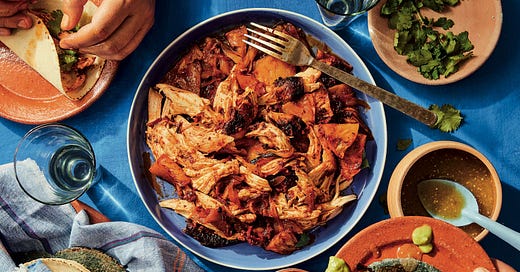We have a problem: a rampant fear of chicken. Or rather, of cooking chicken.
The issue extends even to my own life. No matter how many times I’ve made my “Famous Roast Chicken” for my sister, Anne — no matter if she reads the meat thermometer herself and sees it’s ready — she will, every single time, before taking a bite, ask: “Is this done??”
I don’t take the question personally; I know it has nothing to do with her belief in my skill. It’s just fear. So I posed the question on Instagram this week, and was SHOCKED at how universal Anne’s feeling is. For some of you, like myself, the reassurance of a digital thermometer is enough. For others, the fear goes beyond that, and you end up spending a lot of money on what is ultimately a dry and chewy entree.
I know I can’t change anyone’s feelings, but I desperately want to help. Delicious chicken made in your kitchen IS possible!!! And the fear of it will wane with practice.
The Four Fears of Chicken and How to Combat Them:
1. The fear of “doneness”
Solution: controlling the temperature
Digital Read Thermometers changed my life when it comes to cooking meat. The minute I see 165 pop up on the little screen, I’m filled with both joy and relief. Quick Tip: Just make sure you’re sticking it close to the bone or in the thickest part of the meat for the most accurate read.
Sous Vide is the millennial crock pot in that you set it, forget it, and come home to something perfectly delicious. It uses a water bath technique to bring the meat up to your desired temperature. Since it’s such a gentle and slow process, it retains all the juiciness and flavor. I personally love that it makes meal prepping super easy with no thawing required.
2. The fear of dryness
Solution: Technique
Brining. When salt penetrates meat, it changes the structure of the muscles and fibers, thereby resulting in a more tender and juicy result. This article from The Science of Cooking explains in more detail. I always do a dry brine for skin-on cuts and wet brine of buttermilk or greek yogurt for chicken breast.
Bone-in cuts retain moisture better.
As stated above, SOUS VIDE.
Resting the chicken after cooking. If you cut immediately into it, all the juice runs out. Let it rest for 10 minutes.
If searing, make sure your pan is HOT hot. Longer sauté time means dryer chicken.
Braise it!!! If you like the pull apart texture, this recipe will not disappoint.
3. The fear of skin and bones
Solution: Lose the bones, not the flavor
Use this technique of velveting to produce the most tender morsels from the most bland breast. Also works for boneless skinless chicken thighs.
4. The fear of “ruining it”
Solution: Get resourceful
Use skin-on, bone-in chicken thighs. This is one of the cheapest cuts and happens to be one of my favorites. It’s hard to overcook and has GREAT flavor (especially with crispy skin!)
Repurpose. Let’s say the worst happens and you have dry chicken. Don’t panic. You have options.
Shred it for chicken quesadillas
Dice it small for chicken soup or chili or curry. Putting it back into something with a lot of moisture will give it new life.
SOUS. VIDE. I swear, you cannot ruin even the most basic chicken breast if you sous vide it.
Tips and techniques are all fine and good. But here are a few beginner-friendly recipes by cooking method:
Sous Vide: Citrus Glazed Chicken
Roasted: “Mary’s Chicken”
Skillet: Crispy McCrisperson Chicken Thighs with Herby Peas and Fennel
Braised: Braised Chicken Legs with Fire-Roasted Tomatillo
Grilled: Pollo Al Pastor
I hope that this equips you with the tools and confidence you need to start cooking chicken. If it doesn’t, I’d love to hear from you!! What else might help you conquer the fear of chicken?
Happy Cooking!!
Mary





